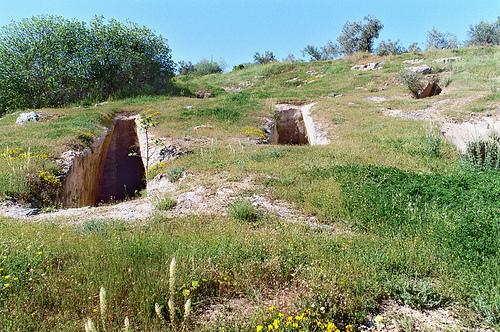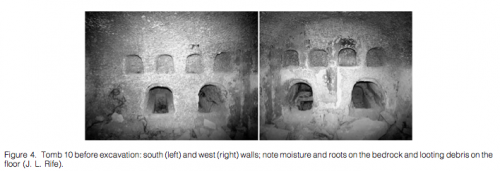Early Roman Chamber Tombs at Kenchreai, Greece
Katy Meyers
Source - http://bonesdontlie.wordpress.com/2011/11/10/early-roman-chamber-tombs-at-kenchreai-greece/
Beginning in 2002, the Kenchreai Cemetery Project has been exploring subterranean chamber tombs that date to the Roman Empire. The site is located on the eastern coast of the Isthmus of Corinth, Greece. The site contains inhumation and cremation human remains, adults and sub-adults, and it is all contained within grand chamber tombs. These tombs are cut straight into the bedrock on the coast, and over the five summers of investigation there have been 30 tombs and 28 cist graves found at the site. By looking at all of the mortuary evidence, including the tombs, the artifacts and the individuals within, archaeologists can better interpret not only funerary practices but the social structure and behavior of the living. Two studies by Ubelaker and Rife (2007, 2011) summarize the findings from both the cremation and inhumation remains at the Kenchreai site.

The tombs themselves are impressive structures, measuring 3.7 by 3.3 meters, and 2.5 meters high. At each entrance to the tomb there is an epitaph revealing when the tomb was first constructed and the original builders, as well as any descendants or freedpersons that were also interred there. Within the tomb, the walls are finished in white or painted plaster. The tombs were used between four to eight generations (a dozen to three dozen individuals), from the middle 1st to late 3rd centuries CE, although some loculi may have continued to be used into the 5th century. Given the immensity of the structures, and the ornate decorations and paintings within some of them, they most likely belong to elite local families. The similarity in construction and decoration suggest that they all belonged to one social group, and that creating a homogenous look was important for communicating that they were affiliated with this elite group. Its is highly likely that this group rose into prominence during Roman occupation because of the increased trading opportunities afforded to them due to their location at an important port.
The burials within the tomb were found in two types of locations. Inhumations were primarily found in loculi (long narrow compartments) cut into the lower portion of the chamber walls. Cremation remains were primarily found within urns placed in niches (small square compartments) cut into the upper portion of the chamber walls. Small portions of cremation remains were also found scattered throughout chamber floors and also in loculi, however these are attributed to displacement of former remains when reusing niches or displacement from grave robbers. Judging by the color and warping of the cremated bones, Ubelaker and Rife argue that the fire used for cremation was both prolonged and extremely hot. Comparison of the number of urns and weight of the cremated remains leads them to conclude that the majority of the cremation was not recovered from the pyre for final internment.

Ubelaker and Rife 2011
Artifacts were found with many of the inhumations, and include jewelry like carved bones, bronze pins, gold hoop earrings, clothing with gold thread and jewels, and some even including coins placed at the mouth. Some loculi contain evidence of wooden coffins, such as traces of wood and nails. The urns that cremation remains were found in are cylindrical vessels with incised, painted, wavy bands on the sides, a lip at the shoulder and conical lids.
While the co-occurrence of inhumation and cremation is not rare, it isn’t well understood. While cremation has occurred throughout Greek and Roman history, its use is found in varying frequencies in different periods. With the rise of the Roman Empire, cremation became much more common in Greece, especially in locations with close ties to the Roman Italy. The tombs were constructed to hold both inhumation and cremation remains, so conservation of space was not an issue. All demographic ages and sexes are represented, so this was not a source of differentiation. Religious affiliation was not likely a factor either, since families traditionally have similar beliefs and the tombs were constructed for single families and their dependents.
Rife et al. (2007) suggest that the variation in burial rite could be a sign of status, with inhumation for family members and cremation for freedpersons and salves. Comparing artifacts, the urns have little to no material objects included in them, and there is little decoration to the urns themselves, whereas the loculi contain a number of artifacts each and some have decoration around them. Since space within the tomb would be valuable, the loculi would cost more than the niches. Loculi also take up the most visible areas of the tomb and are the focus upon entering.
The variation in burial practices at Kenchreai is very interesting, and the interpretation by Rife et al (2007) is quite plausible. However, Morris (1992) suggests that more austere burials in Greece were also a sign of restraint and citizenship, with grave goods falling out of favor. In order to show their democratic spirit, Greeks didn’t have fancy burials and didn’t waste space. In light of this evidence, the true interpretation may be the reverse of Rife et al. (2007). Further analysis of the remains, artifacts and tombs may aid in these interpretations. Since work is still being done to assess the skeletal remains, we can look forward to more reports from this site.
Works Cited
Ubelaker, D., & Rife, J. (2011). Skeletal analysis and mortuary practice in an Early Roman chamber tomb at Kenchreai, Greece International Journal of Osteoarchaeology, 21 (1), 1-18 DOI: 10.1002/oa.1102
Douglas Ubelaker, & Joseph Rife (2007). The practice of cremation in the Roman-era cemetery at Kenchreai, Greece Bioarchaeology of the Near East, 1, 35-57
Rife, Joseph, Melissa Moore Morison, Alix Barbet, Richard K. Dunn, Douglas H. Ubelaker, Florence Monier. 2007.Life and Death at a Port in Roman Greece: The Kenchreai Cemetery Project, 2002-2006. Hesperia: The Journal of the American School of Classical Studies at Athens 76 (1): 143-181
Morris, Ian. 1992. Death Ritual and Social Structure in Classical Antiquity. NY: Cambridge University Press.